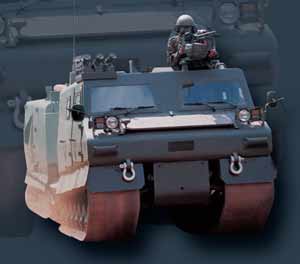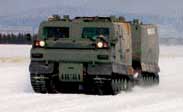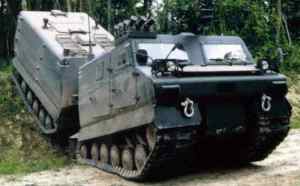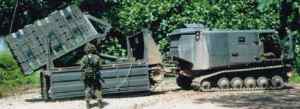| Designation: | Bronco |
 |
|---|---|---|
| Manufacturer: | Singapore Technologies Kinetics Ltd - STK | |
| Product type: | Armoured Vehicles | |
| Name: | Tracked armoured personnel carrier |
Early in 2000, after almost five years of extensive research and development work, Singapore Technologies Kinetics, a part of Singapore Technologies Engineering, revealed their new articulated armoured All-Terrain Tracked Carrier (ATTC).
Although similar in concept to the Swedish BAE Systems Hägglunds Bv 206S and more recent BAE Systems Hägglunds BvS 10 armoured articulated vehicles, Singapore Technologies Kinetics believe that the ATTC is a new generation fully armoured articulated vehicle.
When compared with other vehicles of this type, the ATTC has greater internal volume, greater load carrying capacity and can be modified for a wide range of battlefield missions.
Following extensive trials with an automotive test bed which ran for the first time in 1997, two preproduction ATTC were completed in 1999, one in the troop carrier configuration and the other in a cargo carrying role.
Early in May 2001, Singapore Technologies Kinetics delivered the first of an undisclosed quantity of its new articulated armoured All-Terrain Tracked Carrier (ATTC) vehicles to the Singapore Armed Forces (SAF).
It is understood that the ATTC now operates with the Singapore Technologies Kinetics Bionix infantry fighting vehicle. For export marketing purposes the ATTC is referred to as the Bronco by Singapore Technologies Kinetics.
Although developed for military applications, it is also being marketed for a number of possible civil applications including forestry and oil exploration operations.
It is understood that the ATTC will, in the future, be adopted for a much wider range of battlefield missions by the Singapore Armed Forces.
By mid-2007, the ATTC had undergone extensive trials in a number of counties including Finland, France, Morocco, Turkey and the US.
For a potential Turkish Land Forces Requirement for a vehicle of this type, Singapore Technologies Kinetics has teamed with the Turkish company Otokar. For this programme the Bronco ATTC is called the Sakarya.
In mid-2007 it was stated that about 600 Bronco had been built or were on order for the Singapore Armed Forces.
The ATTC consists of two fully armoured units, front and rear, connected by a specially designed hydraulic articulated joint that features two steering cylinders and two damping cylinders.
The all-welded steel armoured hull provides the occupants with protection from 7.62 mm ball small arms fire and shell splinters but an enhanced modular passive protection package has been developed for the ATTC by IBD of Germany.
The driver is seated at the front on the right (with a left-hand model also being offered) with the vehicle commander to his left with large bulletproof windows to their front.
There are two entry doors in either side of the hull with a bulletproof window in the upper part. The bulletproof windows provide the same level of protection as the hull.
The front unit has four roof hatches, one each for the commander and driver, that open to the rear and another two in the centre of the roof that open inwards.
Entry to the rear unit is via a large door that opens to the right with a two-part roof hatch also provided, although there is considerable flexibility in the design of the vehicle as regards positioning of the hatches and doors. Both front and rear units are fitted with an air conditioning system as standard.
The ATTC is powered by a Caterpillar model 3126B four-stroke turbocharged and charge air-cooled diesel engine developing 350 bhp at 2,400 rpm coupled to an Allison MD3560P fully automatic transmission.
The engine is located in the rear part of the forward unit with the air inlet and outlet in the roof towards the rear. Power is taken from the transmission to the drop box and then to the drive sprockets at the front and rear units.
Suspension is of the rubber bush type with the front and rear unit having six lightweight dual road wheels either side with the drive sprocket at the front and two track return rollers. A mechanical track tensioner is fitted as standard. To save weight the road wheels and drive sprockets are of reinforced plastic.
The endless moulded rubber band tracks have been developed specifically for the ATTC by Soucy International of Canada and are 600 mm wide. These are lighter than conventional steel tracks and are also much quieter. Nominal ground pressure of 60 kpa gives the vehicle exceptional mobility in marginal terrain such as snow and swamp.
The service braking system is of the hydraulic disc type operating on each track with the parking brake being of the hydromechanical type. Steering is hydraulic and very positive even at low speeds. The fully articulated steering makes the vehicle easy to handle in confined spaces and all four tracks are in constant contact with the ground. As an option, a differential lock can also be provided for the ATTC.
The ATTC is fully amphibious being propelled in the water by its tracks at a maximum speed of 4.5 km/h without any preparation apart from activating the two electrically operated bilge pumps in the front and rear units.
The troop carrier version can carry six people in the front unit, three either side, ten in the rear unit, five either side facing inwards, with plenty of space for their equipment. Maximum payload is 1,200 kg for the front unit and 3,000 kg for the rear unit. When fully loaded the vehicle is well balanced as the front and rear units weigh the same.
Typical basic weapon fit would be a roof-mounted 7.62 mm machine gun and banks of three forward firing electrically operated smoke grenade launchers. These are normally mounted at the front of the front cabin.
The cargo carrier can carry 1,200 kg in the front unit and 3,700 kg in the rear unit, which is fitted with drop sides and a drop tailgate. This version retains the amphibious characteristics of the troop-carrying version.
The design of the ATTC is flexible and the system has further growth potential as well as different unit configurations with various engine/transmission combinations.
The ATTC is fully air-portable in a Lockheed Martin C-130 Hercules transport aircraft.
In addition to the basic general troop carrier, three specialised versions have already been revealed: armoured engineer, resupply and ambulance.
The armoured engineer version has sufficient space to carry explosives and obstacle clearing equipment and can also be configured to carry and launch mine clearing systems.
It also has a modular/expandable racking system to suit different operations and an hydraulic source for hydromechanical tools.
The rear cabin is air conditioned for improved comfort. It can carry four fully deployed stretchers with casualties or nine seated casualties in the rear cabin. It also has an integrated tentage system for additional workspace.
The resupply variant has the rear unit fitted with a mechanical handing system and can carry pods of fuel or cargo. Maximum cargo lift height is 1.9 m. Maximum stated cargo load is 3,000 kg.
These include a weapons carrier; for example armed with anti-tank guided missiles, reconnaissance, command and control and internal security vehicle. There is also a possibility of a non-armoured version for the civil market.
Current production Bronco ATTC consists of two units joined together by an articulated coupling which gives the vehicle a high level of cross country mobility. The coupling not only transmits power but also allows pitch/yaw/roll between the two units.
The latest AAV concept allows the Bronco ATTC to couple/decouple automatically to form two separate smaller driven units.
This new AAV concept allows this or any articulated vehicle (including wheeled) to be split into two separate loads for rapid insertion missions using a wider range of tactical helicopters or vertical take-off and landing (VTOL) aircraft.
The main advantage of the AAV concept is the quick change role it offers to any articulated vehicle as it allows an array of front and rear cabin combinations to increase the vehicle's ability to respond to an extended spectrum of missions.
In addition, the AAV has a semi-autonomous rear cabin. When uncoupled the unmanned cabin can be steered by remote control for dangerous missions such as mine clearance. The rear unit can be customised for a variety of independent or complimentary roles.
When operated under its own electric power, the rear cab can move in a silent and stealthy distance of about 5 km. In the autonomous mode it can be used for route proving and reconnaissance missions that are considered too dangerous for the normal manned role.
When used on its own, the front unit can be fitted with a number of specialised attachments. These include a propeller for improved amphibious characteristics, dozer with adjustable blade and even a flail-type mine clearance system.
For trials purposes the Bronco ATTV has been fitted with the Singapore Technologies Kinetics 120 mm Super Rapid Advanced Mortar System (SRAMS), which has been developed as a private venture.
This muzzle-loaded mortar has a number of advanced features including a high rate of fire, advanced cooling system and is coupled to a computerised fire-control system. Details of this are given in a separate entry. It can also be integrated onto other tracked and wheeled chassis.
The first customer for the 120 mm SRAMS is the UAE who is integrating it on the rear of a BAE Systems Land Systems OMC RG-31 (4 × 4) mine protected vehicle.
Carries a pod with 2,700 litres of fuel plus rapid fuel transfer system.
Military mobile workshop with full facilities such as hoist, winch, electric generator and air compressor.
|
||||||||||||||||||||||||||||||||
|
||||||||||||||||||||
All contracts...
Related Articles |
|
Tankies in Helmand start work in the Warthog vehicle (08.12.2010) |
|
ST Kinetics Unveils New Bronco Variant Prototype at Eurosatory 2010 (14.06.2010) |
|
ST Kinetics Targets Major Opportunities in Indian Defence (16.01.2010) |
|
Warthog vehicle arrives in UK for Afghan modifications (22.11.2009) |
|
ST Kinetics Broncos And Total 40mm Solutions At DSEi 2009 (09.09.2009) |
|
UK Orders Bronco Armored All-Terrain Vehicles (21.12.2008) |
 |
 |
 |
 |

